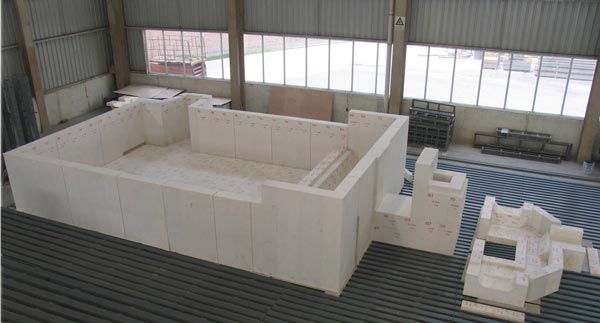
Product List
Success Case
Contact Us
- 0086 371 63838939
- 0086 371 63835539
- sales@sunriserefr.com
- tkfanyi
- No.36 Fengchan Road, Zhengzhou City

News
Factors for Erosion of Fused Cast AZS Sidewall Block in Glass Furnaces
- More related products
- Fused Cast AZS
- Fused Cast Alumina Block
- Fused Cast High Zirconia Block
- Fused Cast Skid Rail Block
In addition to the weakness of the internal structure, the erosion of fused cast AZS sidewall block in glass furnaces is up to physical and chemical effects. This is a complex physical and chemical process.

1. Physical effects
The sidewall of the glass furnace, in the long term run, is repeatedly subjected to thermal shock. Its surface undergoes repeated shrinkage and expansion. Excessive fatigue results in the damage of the structure, an increase in surface cracks and loose structure. Therefore, the block cracks and spalls under the erosion of air flow, materials and molten glass and this process continues to be repeated.
2. Chemical effects
The chemical effects have more complex and severer erosion on the fused cast AZS block. The chemical effects can be divided into four aspects.
1) The exudation of glass phase
The fused cast AZS sidewall block is subjected to high temperature glass liquid (>1500℃) in the long term run. The glass phase of the AZS block is gradually melted and exuded. The alkali glass liquid containing Na2O will penetrate into the brick along the pores and cracks of the brick and diffuse into the exuded glass phase. The mutual penetration between them reduces the viscosity and liquidity of the exuded glass liquid, Thereby enhancing the erosion behavior and expanding the erosion in depth.
2) The damage of the skeleton
With the increasing of the erosion of glass liquid in depth, the minerals in the skeleton of fused cast AZS block are gradually infiltrated and surrounded by glass liquid containing Na2O. The skeleton begins to be eroded. First, mullite is melted. Mullite is decomposed into α-AI2O3 and SiO2 and then some α-AI2O3 is transformed into β-AI2O3. With the rising of temperature, Al2O3 is entirely melted in glass liquid and baddeleyite and corundum are also damaged and further dispersed and melted.
3) The crystallization of new minerals
Some of the skeleton minerals of the AZS block are melted in the glass liquid and change the composition of the original glass liquid. Since the ratios of SiO2, AI2O3 and Na2O in the glass liquid are close to the composition of nepheline, there is a large amount of nepheline penetrated.
4) The erosion of fused cast AZS Block
Since the density of nepheline is lower than that of the fused cast AZS Block, the crystallization of nepheline is accompanied with large volume expansion, which makes the structure loose. Although the melting of crystals in the block can improve the viscosity of glass liquid and can bond and protect the loose structure, it still cannot prevent erosion by the air flow, materials and glass liquid. AZS block cracks and spalls into glass liquid and forms stones. The wound surface continues to be eroded by glass liquid and spall, resulting in the erosion and decomposing of AZS block.
- Read more
- Practical Application and Abrasion Resistance of Refractory Materials
- Fused Cast AZS 33 Brick With Good Dense Structure For Glass Furnace
- Fused Cast AZS 36 Brick With High Corrosion Resistance To Glass Liquid
- Long Service Life Brick-Fused Cast AZS 41 Brick With Almost No Shrinkage Cavities
- Fused Cast Alpha-Beta Alumina Brick Which Can Minimize Contamination To Glass Liquid
Leave Message
For more information on any of our products please get in touch using the form below. One of our sales team will respond to your enquiry as soon as possible.

Copyright © 2014 Zhengzhou Sunrise Refractory Co., Ltd. 豫ICP备13002126号












